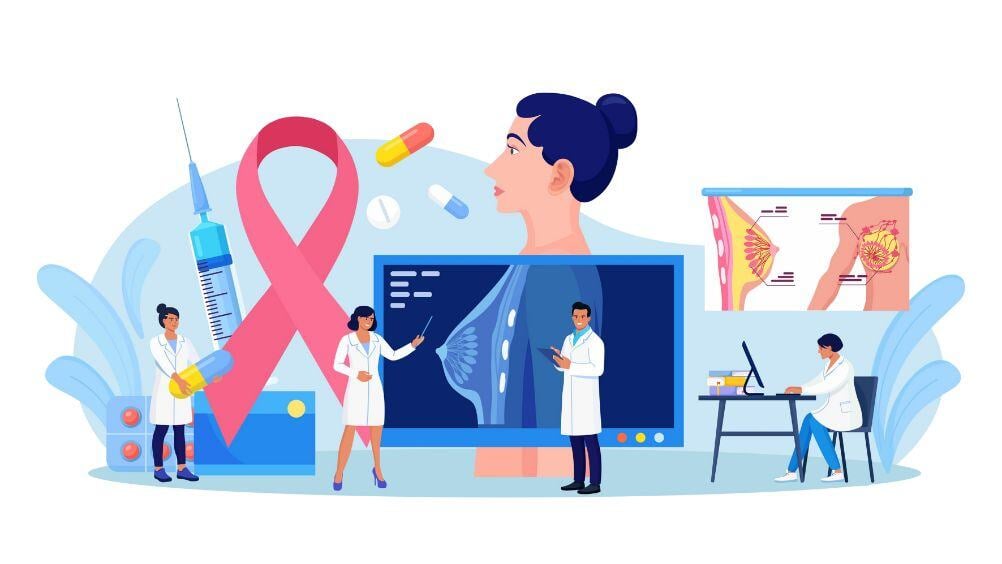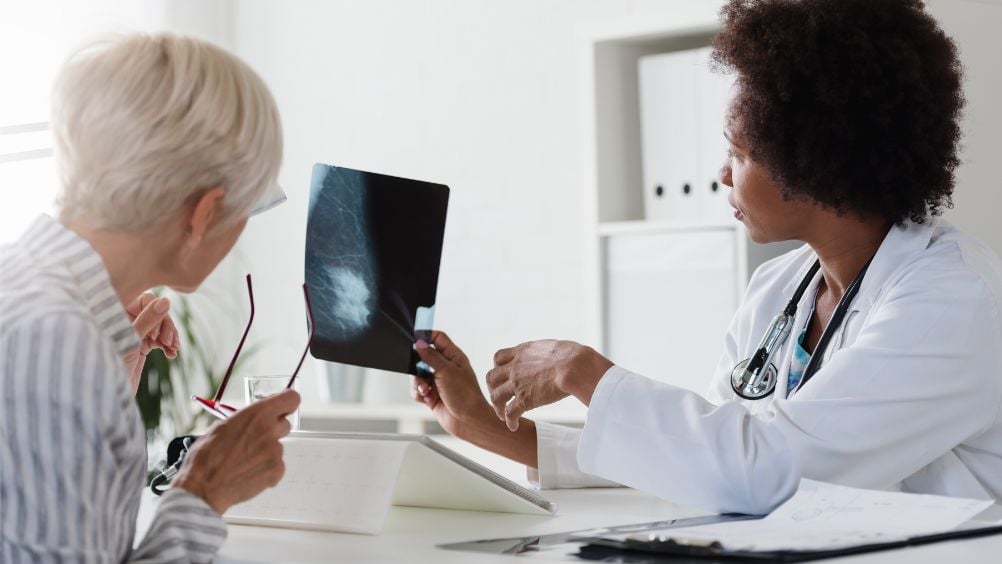After a breast biopsy, a doctor called a pathologist will take a close look at the tissue under a microscope. Based on what is found, a report is created with various information, including whether breast cancer is present.
It's helpful to get familiar with the terms you might see in the report, especially if cancer is detected. That's because the results will guide treatment recommendations given by an oncologist. Let's look at what you might see in the report so you can prepare for your first appointment with a breast cancer specialist.
What Information Is Found In a Pathology Report?
Understanding the language in a pathology report can be challenging, but your oncologist can help clarify any confusing points. Most breast pathology reports include the following sections:
Specimen Description
This section thoroughly explains the type of tissue and its source (e.g., breast, lymph nodes).
Gross (Macroscopic) Description
This section summarizes the appearance of the tissue to the naked eye before microscopic examination, including size, weight, color, texture, and other notable features.
Microscopic Description
A microscopic description summarizes the appearance of the sample under a microscope. If cells appear abnormal, they will be described. There are varying degrees of abnormal cells, including noninvasive cancer (in-situ carcinoma) and invasive (infiltrating) carcinoma. Noninvasive cancers remain confined to the breast's milk ducts or lobules, while invasive means cancerous cells have spread outside of the ducts or lobules into other tissue removed in the sample.
Tumor Margin
If the sample being analyzed was removed during surgery rather than a needle biopsy, there will be tissue removed from around the suspected cancerous tissue. This is called a margin. A positive, or involved, margin means cancer cells are present on the edges of the tissue sample, while a negative margin indicates the absence of cancer cells in the tissue around it. A "close" margin means that cancer cells are not present at the edge but are close to it, which could imply the need for further tissue removal.
Final Diagnosis
This section is the most important part of the pathology report and provides a summary of the primary characteristics of breast cancer, if it was found. This includes the breast cancer type, tumor grade, lymph node involvement, hormone receptor status, and HER2 status.
Type of Breast Cancer
The report may specify the type of breast cancer, which indicates if it is invasive and where it originated in the breast. Treatment may differ depending on what type of breast cancer is found.
- Ductal Carcinoma In Situ (DCIS): Cancer is present but remains within the milk ducts and is non-invasive.
- Invasive Ductal Carcinoma (IDC): Cancer develops in the milk ducts and extends into the surrounding breast tissues. IDC is the most common type of breast cancer, accounting for about 80% of cases.
- Invasive Lobular Carcinoma (ILC): Cancer originates inside the lobules and extends into the surrounding breast tissues. ILC accounts for about 10-15% of cases.
The report may also mention other less common types such as inflammatory breast cancer, Paget’s disease, phyllodes tumor, and angiosarcoma.
If lobular carcinoma in situ (LCIS) is listed, it's not a cancer diagnosis but indicates an increased risk of developing invasive cancer in the future. LCIS is an overgrowth of abnormal cells in the milk glands or lobules, which increases the risk of developing invasive cancer in the future.
Tumor Grade
The grade of breast cancer describes how closely the cancer cells look to healthy cells and how quickly the tumor might grow and spread. Here are some factors a pathologist may consider when grading breast cancer:
- Whether the tumor tissue contains normal breast ducts
- The size and shape of the breast tumor cells
- The growth and division speed of the tumor cells
Each of these factors is given a final score, and the grade is described as follows:
- Grade 1 or well-differentiated: Cancer cells more closely resemble typical breast cells and have a slower growth rate.
- Grade 2 or moderately differentiated: Cells are somewhat abnormal. The pathologist found some well-differentiated and some poorly-differentiated cells.
- Grade 3 or poorly differentiated: Cells are highly abnormal and typically fast-growing.
Vascular Invasion and Lymph Node Involvement
Vascular invasion describes whether cancer cells spread to the blood vessels in the breast.
Lymph node involvement will indicate whether there was cancer found in the lymph nodes near the breast. If cancer is found there, it will be described as one of the following:
- Microscopic: A few cancer cells are only visible under a microscope
- Gross: Many cancer cells are visible or felt without a microscope
- Extracapsular Extension: Cancer cells that have spread beyond the lymph node's capsule or wall
If there is cancer found in the lymph nodes, additional treatments will likely be needed because the cancer cells can travel and grow in other areas of the body. Lymph node biopsies are sometimes performed separately from a breast biopsy, depending on whether the biopsy is performed at the time of surgery or before surgery using a needle biopsy.
Hormone Receptor Status
The hormone receptor status of breast cancer refers to whether the breast cancer cells are fueled by estrogen and/or progesterone due to hormone receptors inside the tumor cells. Based on hormone receptor status, your breast cancer may be more susceptible to certain medications. This will guide what treatment options your oncologist will recommend.
Your report may include:
- A percentage between 0 and 100% indicates the number of receptor-positive cells out of 100 tested cells.
- An "Allred score " is a combination of the percent of receptor-positive cells and their intensity, ranging from 0 to 8. A higher score indicates more hormone receptors were found.
- The word "positive" or "negative" indicates whether there are receptors on the cancer cells that attract estrogen, progesterone, or both.
HER2 Status
HER2 is a protein that may be overexpressed in some breast cancers. A HER2-positive status will be noted in the report if present.
Learn more about breast cancer and hormone receptor status.
Breast Pathology Reports Guide Cancer Staging & Treatment
Cancer staging is crucial for planning cancer treatment and predicting outcomes. It also helps organize information using a common language for the care team.
The TNM staging system is used for breast cancer, where TNM stands for:
- T = Tumor size
- N = Lymph Node status (the number and location of lymph nodes with cancer)
- M = Metastases (whether or not the cancer has spread to other parts of the body)
The numbers or letters after T, N, and M provide more detailed information about each characteristic. A higher number indicates more advanced cancer.
The stage is represented by a number on a scale of 0 to IV (4), with 0 referring to non-invasive cancers and stage IV referring to invasive cancers that have spread beyond the breast. If cancer is stage IV at the time of diagnosis it may be referred to as de novo metastatic breast cancer.
Learn more about breast cancer stages.
What Comes Next After a Breast Cancer Diagnosis?
After receiving a diagnosis, it's important to consult with an oncologist specializing in breast cancer. You will most likely also need a breast cancer surgeon. However, in many cases, the oncologist leads the treatment team, which includes the surgeon and other physicians such as the radiation oncologist.
At Willamette Valley Cancer Institute, our breast cancer specialists are here to help you understand a diagnosis and create a personalized treatment plan that meets your needs. We also offer second opinions regarding diagnoses and treatment plans, which are often covered by insurance.
If you're in or around Willamette Valley, request an appointment with one of our breast cancer doctors. We have cancer centers in Albany, Corvallis, Eugene, Lincoln City, Florence, and Newport, Oregon, to help meet your needs close to home.


